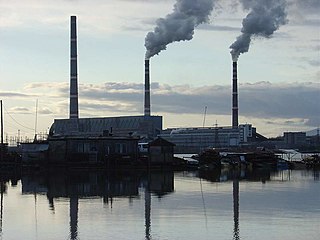
A carbon tax is a tax levied on the carbon emissions from producing goods and services. Carbon taxes are intended to make visible the hidden social costs of carbon emissions. They are designed to reduce greenhouse gas emissions by essentially increasing the price of fossil fuels. This both decreases demand for goods and services that produce high emissions and incentivizes making them less carbon-intensive. When a fossil fuel such as coal, petroleum, or natural gas is burned, most or all of its carbon is converted to CO2. Greenhouse gas emissions cause climate change. This negative externality can be reduced by taxing carbon content at any point in the product cycle.

Biofuel is a fuel that is produced over a short time span from biomass, rather than by the very slow natural processes involved in the formation of fossil fuels such as oil. Biofuel can be produced from plants or from agricultural, domestic or industrial biowaste. Biofuels are mostly used for transportation, but can also be used for heating and electricity. Biofuels are regarded as a renewable energy source. The use of biofuel has been subject to criticism regarding the "food vs fuel" debate, varied assessments of their sustainability, and possible deforestation and biodiversity loss as a result of biofuel production.

Energy is sustainable if it "meets the needs of the present without compromising the ability of future generations to meet their own needs." Definitions of sustainable energy usually look at its effects on the environment, the economy, and society. These impacts range from greenhouse gas emissions and air pollution to energy poverty and toxic waste. Renewable energy sources such as wind, hydro, solar, and geothermal energy can cause environmental damage, but are generally far more sustainable than fossil fuel sources.

Climate change mitigation (or decarbonisation) is action to limit the greenhouse gases in the atmosphere that cause climate change. Greenhouse gas emissions are primarily caused by people burning fossil fuels such as coal, oil, and natural gas. Phasing out fossil fuel use can happen by conserving energy and replacing fossil fuels with clean energy sources such as wind, hydro, solar, and nuclear power. Secondary mitigation strategies include changes to land use and removing carbon dioxide (CO2) from the atmosphere. Governments have pledged to reduce greenhouse gas emissions, but actions to date are insufficient to avoid dangerous levels of climate change.

A carbon footprint (or greenhouse gas footprint) is a calculated value or index that makes it possible to compare the total amount of greenhouse gases that an activity, product, company or country adds to the atmosphere. Carbon footprints are usually reported in tonnes of emissions (CO2-equivalent) per unit of comparison. Such units can be for example tonnes CO2-eq per year, per kilogram of protein for consumption, per kilometer travelled, per piece of clothing and so forth. A product's carbon footprint includes the emissions for the entire life cycle. These run from the production along the supply chain to its final consumption and disposal.

Transportation demand management or travel demand management (TDM) is the application of strategies and policies to increase the efficiency of transportation systems, that reduce travel demand, or to redistribute this demand in space or in time.

Chemically, black carbon (BC) is a component of fine particulate matter. Black carbon consists of pure carbon in several linked forms. It is formed through the incomplete combustion of fossil fuels, biofuel, and biomass, and is one of the main types of particle in both anthropogenic and naturally occurring soot. Black carbon causes human morbidity and premature mortality. Because of these human health impacts, many countries have worked to reduce their emissions, making it an easy pollutant to abate in anthropogenic sources.

Aircraft engines produce gases, noise, and particulates from fossil fuel combustion, raising environmental concerns over their global effects and their effects on local air quality. Jet airliners contribute to climate change by emitting carbon dioxide, the best understood greenhouse gas, and, with less scientific understanding, nitrogen oxides, contrails and particulates. Their radiative forcing is estimated at 1.3–1.4 that of CO2 alone, excluding induced cirrus cloud with a very low level of scientific understanding. In 2018, global commercial operations generated 2.4% of all CO2 emissions.

Greenhouse gas (GHG) emissions from human activities intensify the greenhouse effect. This contributes to climate change. Carbon dioxide, from burning fossil fuels such as coal, oil, and natural gas, is one of the most important factors in causing climate change. The largest emitters are China followed by the United States. The United States has higher emissions per capita. The main producers fueling the emissions globally are large oil and gas companies. Emissions from human activities have increased atmospheric carbon dioxide by about 50% over pre-industrial levels. The growing levels of emissions have varied, but have been consistent among all greenhouse gases. Emissions in the 2010s averaged 56 billion tons a year, higher than any decade before. Total cumulative emissions from 1870 to 2022 were 703 GtC, of which 484±20 GtC from fossil fuels and industry, and 219±60 GtC from land use change. Land-use change, such as deforestation, caused about 31% of cumulative emissions over 1870–2022, coal 32%, oil 24%, and gas 10%.
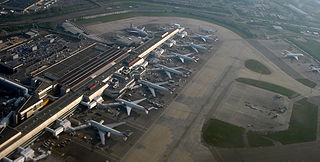
Air transport in the United Kingdom is the commercial carriage of passengers, freight and mail by aircraft, both within the United Kingdom (UK) and between the UK and the rest of the world. In the past 25 years the industry has seen continuous growth, and the demand for passenger air travel in particular is forecast to increase from the current level of 236 million passengers to 465 million in 2030. One airport, Heathrow Airport, is amongst the top ten busiest airports in the world. More than half of all passengers travelling by air in the UK currently travel via the six London area airports. Outside London, Manchester Airport is by far the largest and busiest of the remaining airports, acting as a hub for the 20 million or so people who live within a two-hour drive. Regional airports have experienced the most growth in recent years, due to the success of low-cost carrier airlines over the last decade.

Carbon dioxide removal (CDR) is a process in which carbon dioxide is removed from the atmosphere by deliberate human activities and durably stored in geological, terrestrial, or ocean reservoirs, or in products. This process is also known as carbon removal, greenhouse gas removal or negative emissions. CDR is more and more often integrated into climate policy, as an element of climate change mitigation strategies. Achieving net zero emissions will require first and foremost deep and sustained cuts in emissions, and then—in addition—the use of CDR. In the future, CDR may be able to counterbalance emissions that are technically difficult to eliminate, such as some agricultural and industrial emissions.

The environmental effects of transport are significant because transport is a major user of energy, and burns most of the world's petroleum. This creates air pollution, including nitrous oxides and particulates, and is a significant contributor to global warming through emission of carbon dioxide. Within the transport sector, road transport is the largest contributor to global warming.

Individual action on climate change can include personal choices with regards to diet, travel, lifestyle, consumption of goods and services, family size and so on. Individuals can also get active in local and political advocacy work around climate action. People who wish to reduce their carbon footprint, can for example reduce air travel and driving cars, they can eat mainly a plant-based diet, use consumer products for longer, or have fewer children. Avoiding meat and dairy foods has been called "the single biggest way" how an individual can reduce their environmental impact. Scholars find that excessive consumption is more to blame for climate change than population increase. High consumption lifestyles have a greater environmental impact, with the richest 10% of people emitting about half the total lifestyle emissions.
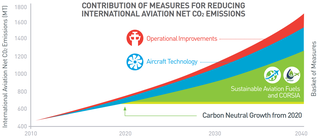
The Carbon Offsetting and Reduction Scheme for International Aviation (CORSIA) is a carbon offset and carbon reduction scheme to lower CO2 emissions for international flights, to curb the aviation impact on climate change.

Flight shame or flygskam is an anti-flying social movement, with the aim of reducing the environmental impact of aviation. Flight shame refers to an individual's uneasiness over engaging in consumption that is energy-intense and climatically problematic. It also reflects on air travelers as people involved in socially undesirable activities, and adaptive behaviour as described in the related Swedish term smygflyga. It started in 2018 in Sweden and gained traction the following year throughout northern Europe. Flygskam is a Swedish word that literally means "flight shame". The movement discourages people from flying to lower carbon emissions to thwart climate change.
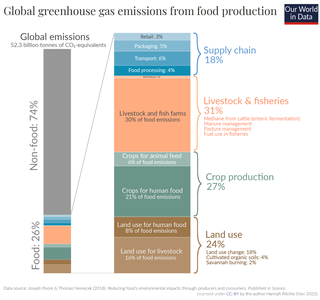
The amount of greenhouse gas emissions from agriculture is significant: The agriculture, forestry and land use sector contribute between 13% and 21% of global greenhouse gas emissions. Emissions come from direct greenhouse gas emissions. and from indirect emissions. With regards to direct emissions, nitrous oxide and methane make up over half of total greenhouse gas emission from agriculture. Indirect emissions on the other hand come from the conversion of non-agricultural land such as forests into agricultural land. Furthermore, there is also fossil fuel consumption for transport and fertilizer production. For example, the manufacture and use of nitrogen fertilizer contributes around 5% of all global greenhouse gas emissions. Livestock farming is a major source of greenhouse gas emissions. At the same time, livestock farming is affected by climate change.

A climate target, climate goal or climate pledge is a measurable long-term commitment for climate policy and energy policy with the aim of limiting the climate change. Researchers within, among others, the UN climate panel have identified probable consequences of global warming for people and nature at different levels of warming. Based on this, politicians in a large number of countries have agreed on temperature targets for warming, which is the basis for scientifically calculated carbon budgets and ways to achieve these targets. This in turn forms the basis for politically decided global and national emission targets for greenhouse gases, targets for fossil-free energy production and efficient energy use, and for the extent of planned measures for climate change mitigation and adaptation.

The COVID-19 pandemic has had an impact on the environment, with changes in human activity leading to temporary changes in air pollution, greenhouse gas emissions and water quality. As the pandemic became a global health crisis in early 2020, various national responses including lockdowns and travel restrictions caused substantial disruption to society, travel, energy usage and economic activity, sometimes referred to as the "anthropause". As public health measures were lifted later in the pandemic, its impact has sometimes been discussed in terms of effects on implementing renewable energy transition and climate change mitigation.

Climate change in South Africa is leading to increased temperatures and rainfall variability. Evidence shows that extreme weather events are becoming more prominent due to climate change. This is a critical concern for South Africans as climate change will affect the overall status and wellbeing of the country, for example with regards to water resources. Just like many other parts of the world, climate research showed that the real challenge in South Africa was more related to environmental issues rather than developmental ones. The most severe effect will be targeting the water supply, which has huge effects on the agriculture sector. Speedy environmental changes are resulting in clear effects on the community and environmental level in different ways and aspects, starting with air quality, to temperature and weather patterns, reaching out to food security and disease burden.
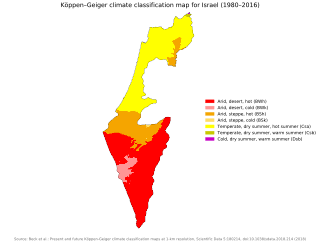
Israel, like many other countries in the Middle East and North Africa, experiences adverse effects from climate change. Annual and mean temperatures are increasing in Israel, with mean temperature expected to increase between 1.6 and 1.8 °C by 2100. There is a reduction in annual precipitation and delayed winter rains. Israel is already experiencing droughts and water shortages. Heatwaves are other natural hazards expected to increase with climate change.



























